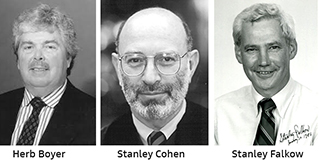RECOMBINANT DNA FOUNDERS
While attending a
conference in Hawaii Boyer, Cohen
and Falkow and having a
sandwich at a Waikiki Deli scribbled out on paper napkins
an experiment to use ECO-R1 to manipulate a bacterial
plasmid and make a recombinant DNA plasmid.
Many have said that this
moment was the origins of a commercial biotech industrial
revolution.
Within 5 months Boyer and Cohen used ECO-R1 to put a DNA piece, that imparted bacterial antibiotic resistance, into a plasmid (pSC101) and when introduced into E.Coli enabled resistance to that antibiotic.
In 1973 John Morrow of Paul Berg's lab at Stanford using the protocols of Cohen and Boyer put frog rDNA into a plasmid and the plasmid was able to make rRNA in bacterial cells, establishing that the techniques would work with vertebrate DNA as well.
Within 5 months Boyer and Cohen used ECO-R1 to put a DNA piece, that imparted bacterial antibiotic resistance, into a plasmid (pSC101) and when introduced into E.Coli enabled resistance to that antibiotic.
In 1973 John Morrow of Paul Berg's lab at Stanford using the protocols of Cohen and Boyer put frog rDNA into a plasmid and the plasmid was able to make rRNA in bacterial cells, establishing that the techniques would work with vertebrate DNA as well.

A global debate about the
biohazards of combining DNAs and the fears of creating
freakish organisms lead to the Asilonmar Conference in
February 1975... a debate that still rages to this day.